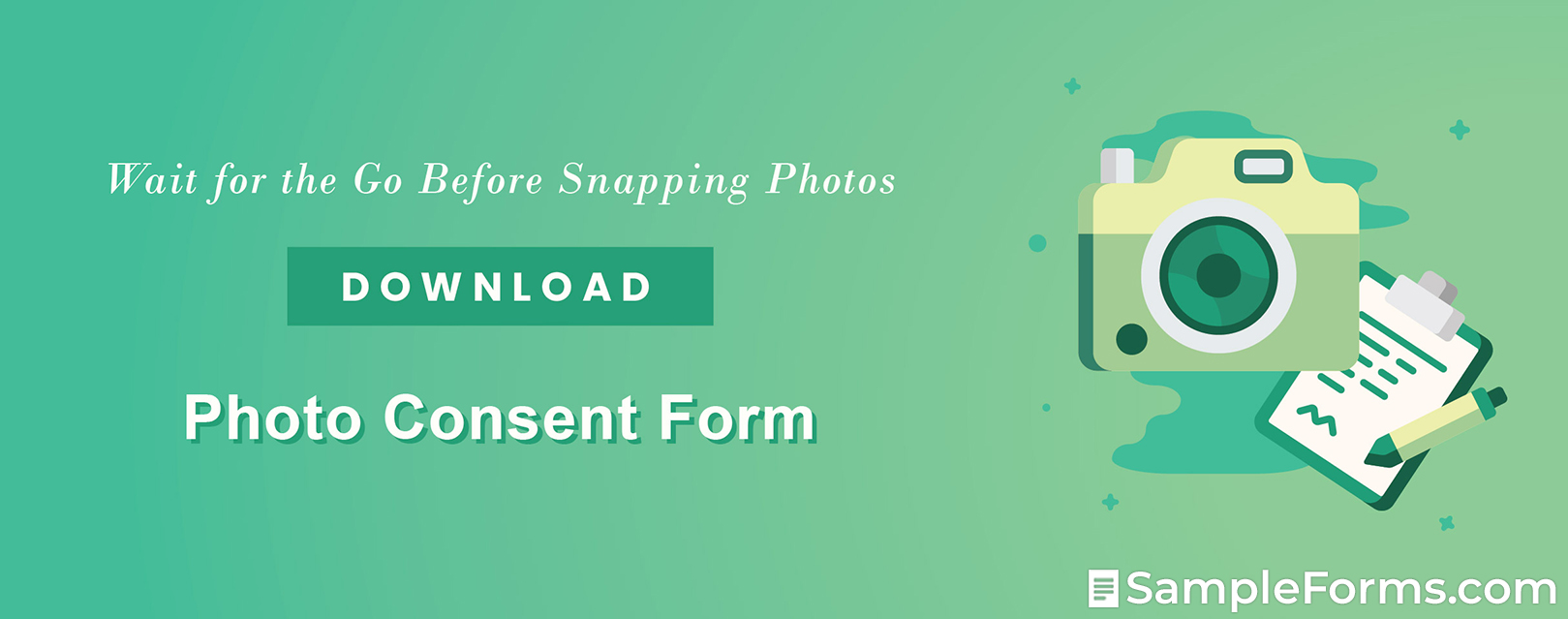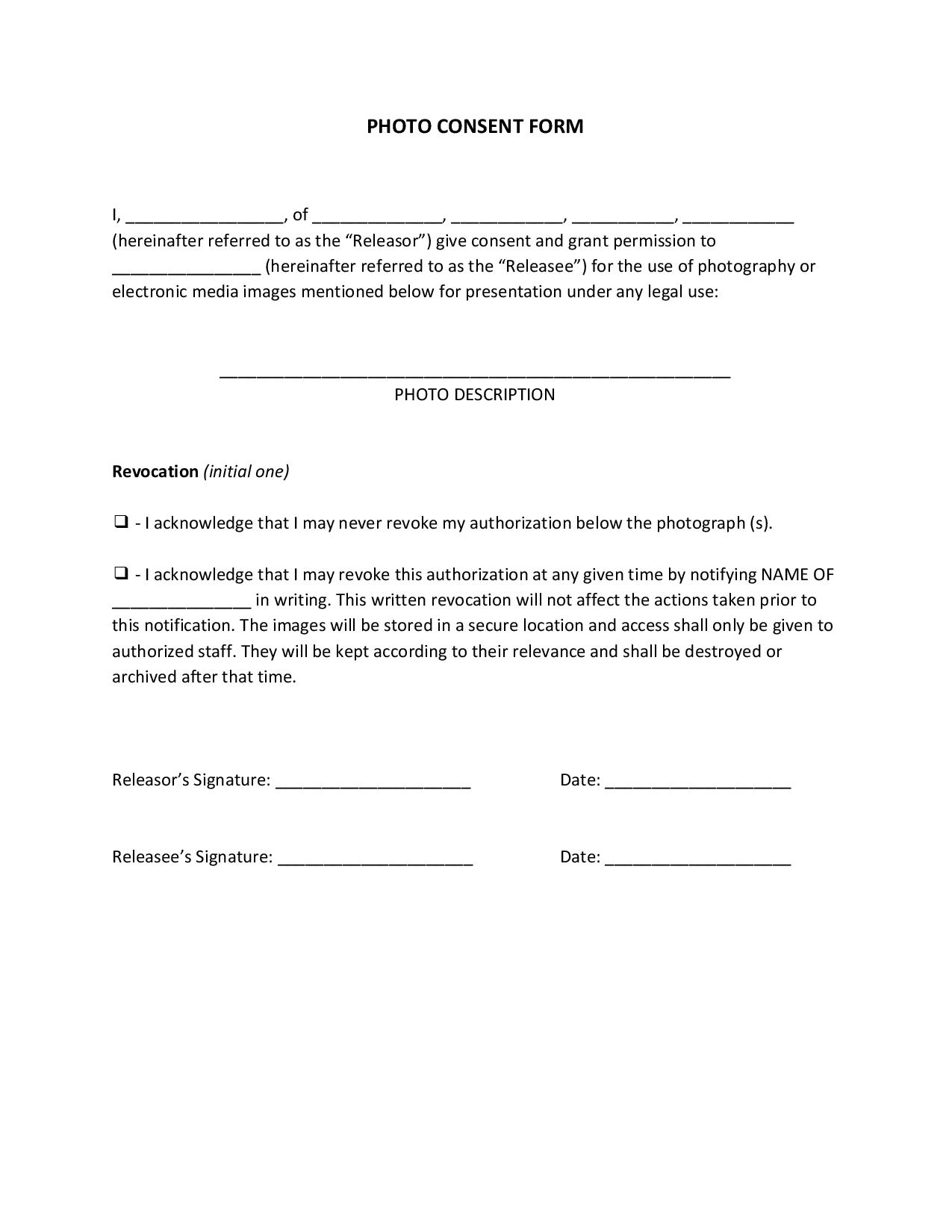- Eviction Notice Forms
- Power of Attorney Forms Forms
- Bill of Sale (Purchase Agreement) Forms
- Lease Agreement Forms
- Rental Application Forms
- Living Will Forms Forms
- Recommendation Letters Forms
- Resignation Letters Forms
- Release of Liability Agreement Forms
- Promissory Note Forms
- LLC Operating Agreement Forms
- Deed of Sale Forms
- Consent Form Forms
- Support Affidavit Forms
- Paternity Affidavit Forms
- Marital Affidavit Forms
- Financial Affidavit Forms
- Residential Affidavit Forms
- Affidavit of Identity Forms
- Affidavit of Title Forms
- Employment Affidavit Forms
- Affidavit of Loss Forms
- Gift Affidavit Forms
- Small Estate Affidavit Forms
- Service Affidavit Forms
- Heirship Affidavit Forms
- Survivorship Affidavit Forms
- Desistance Affidavit Forms
- Discrepancy Affidavit Forms
- Guardianship Affidavit Forms
- Undertaking Affidavit Forms
- General Affidavit Forms
- Affidavit of Death Forms
Photo Consent Form
Photos capture moments and tell stories without captions. They communicate to the viewers more than some stories ever will. But at some point, photos can be considered as harassment or abuse, especially if one takes it without the consent of the subject. Obtain consent from the subject with the use of a photo consent form. A photo consent form ensures that you will not be violating any rights and that you are legally releasing images. Read more about this consent form below. Read More
What Is a Photo Consent Form?
A photography or photo consent form is a form filled out by the releasor (owner of the images or photographs) to permit the releasee (person seeking the authorization) to release photos. These photos are usually released to the public through television or social media platforms for specific purposes. It also has a revocation subsection wherein the releasee can revoke the authorization at any given time.
How to Create a Photo Consent Form
Photos are used for multiple purposes—in business (relevant images in an article are believed to get 94% more views), in the medical field (a patient’s before and after surgery photos), and in the academe (school-related affairs). Make sure the subject of these photos is aware before releasing them to the public. Create a photo consent form with the help of these tips:
1. Download a Template
Templates are the quickest way of getting a photo consent form. They are preformatted to get the job done easier, and you only need to fill in the missing information to complete the form. What’s nice about templates is that they’re modifiable if they do not suit your preferences.
2. Identify the Releasor
The releasor can be the subject of the photo, the owner of the said photo, or both. The consent form should start with the full, legal name of the releasor and their mailing address.
3. Include a Description of the Photos
The consent form should include a brief description of the photos to be released. Do these photos have a group of students, children, or parents? Or business-owners perhaps? Detail them in the description subsection to be easily identified. The description also helps avoid misidentifying one picture from another.
4. Include a Revocation Clause
Include a revocation clause in case the owner of the photos decides to annul their authorization. The releasor has two choices: the first choice is that the releasor loses the chance to revoke the permission, and the second one gives them the right to revoke the permission at any given time. If ever they choose the second one, the choices made before the cancellation will not be affected, and the photos will be secured and thrown after.
5. Sign the Consent Form
Once the previous fields have been filled out, both the releasor and the releasee should sign the consent form. They should be dated signatures in case of future disputes. Take note that minors can’t get themselves involved in signing an agreement such as this. A parent or a legal guardian should represent them. Both parties should have copies of the photo consent form for personal records.
Once the consent form is signed, the releasor has no control over how the releasee will use the photos and which photos to be released. However, they can always revoke their authorization if ever they feel uncomfortable in the future.
Frequently Asked Questions
Is there a law prohibiting me from taking someone else’s photo?
There is no general rule prohibiting you from taking someone else’s photo as long as it doesn’t infringe on important social interests such as the right of privacy, national security, and protection of security. If you take a photo of a person in a public setting, you are not legally liable. However, if you take the photo inside the person’s house and you decide to upload it on social media, then you may face legal consequences.
How do I obtain permission to take a person’s photo?
According to Stanford, first, you should determine if the photos need permission. Second, you have to determine who the owner is. The third is to determine the needed rights. Then, contact the owner and communicate if there is a need for payment. And lastly, put the agreement in writing.
Does a photographer own the photos taken by them?
Yes. The photographer owns the photos taken by them because it is considered intellectual property. If a person wishes to use a photo that is not exclusively theirs to use, they can use stock photography.
How can I ask permission to obtain a photo legally?
The most obvious way to ask permission is to ask permission from the owner. According to AMD Law, you have to make sure that the person actually has the legal right to license the image. You should also explain how you are going to use it and give them a URL of where the photo is to be posted.
How do you define fair use for images?
According to Lib Guides, fair use for images pertains to the usage of copyrighted images without seeking permission from the copyright owner. Here are four factors to consider in fair use:
- The copyrighted work’s nature
- The effect of its use in the targeted market
- The character and purpose of how it is used (scholarship, teaching, study, and research)
- The substantiality and amount of the part taken
Photos have long been used to communicate with the masses and for self-promotion. It has to convey the raw emotions to speak to the intended audience, and humans are often the subjects of these. Now, why do we ask for consent? Multiple people are uncomfortable with having their photos taken, and one way to respect that decision is to seek their consent first. Written consent is preferable to verbal because you have evidence that they have consented to have their photos released. So before you go around releasing their photos to the public, it’s wise to use a photo consent form first.

